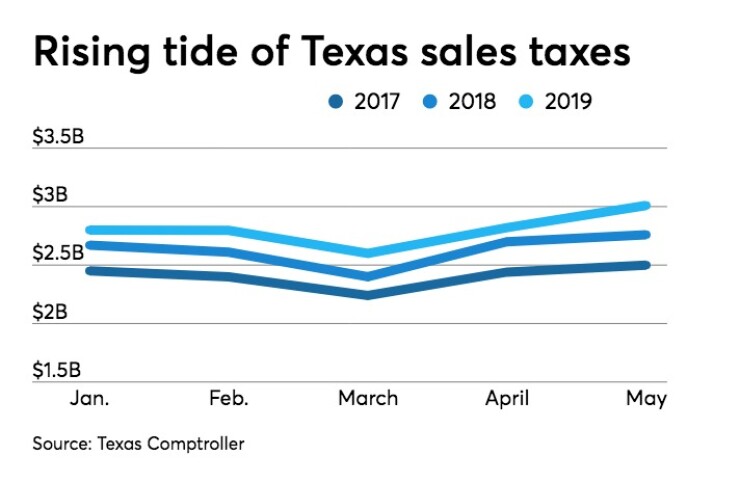Texas’ monthly sales tax collections surpassed $3 billion for the first time in the state’s history in May, marking the 21st consecutive monthly record.
Revenues of $3.01 billion in the May report were 9% higher than those recorded the same month in 2019. The previous record for any month came in November, when revenues hit $2.988 billion on a 7% year-over-year increase.

The May report covers sales in April and tabulated in May. Comptroller Glenn Hegar reported the results June 4.
“State sales tax revenue growth was propelled by both business and consumer spending,” Hegar said. “The strongest growth was in remittances from the manufacturing, wholesale trade and services sectors, with strength apparent in the retail trade sector as well.”
On Friday, Hegar cautioned that President Trump’s plan to impose a 5% tariff on all products from Mexico beginning June 10 could cool the state’s economy. The tariffs are supposed to rise to 25% by November unless Trump deems that Mexico has taken adequate steps to halt illegal immigration into the U.S.
With oil prices rising until last month, Texas enjoyed a strong increase in production taxes.
Natural gas production taxes brought the state $129 million, up 28.4% from May 2018, and oil production taxes of $367.3 million were 16.2% higher than the same month last year.
Hegar also said state franchise tax revenue for May was $3.47 billion. Revenue from the tax levied on businesses was up 7.4% from May 2018, slightly above projections presented in the Biennial Revenue Estimate in January.
Total sales tax revenue for the three months ending in May 2019 was up 6.9% compared to the same period a year ago, Hegar said. Sales tax is the largest source of funding for the state budget, accounting for 57% of all tax collections.
The May report also showed motor vehicle sales and rental taxes rising 1.3% to $429.5 million and motor fuel taxes up 2% to $316 million.
In its most recent report, the Texas Workforce Commission reported that growth in the state’s economy continued in April, with 28,900 seasonally adjusted non-farm positions added over the month. Texas’ seasonally adjusted unemployment rate fell to 3.7%, returning to an all-time record low last held in December of 2018. April marked the 108th consecutive month of annual growth for total non-farm employment.
Private sector employers added 283,000 jobs over the year. Private annual employment growth was at 2.7% in April and has held above 2% since October 2017, TWC reported.
The Midland Metropolitan Statistical Area in the oil-producing Permian Basin recorded April’s lowest unemployment rate among Texas MSAs with a non-seasonally adjusted rate of 1.7%, followed by the neighboring Odessa MSA which recorded at 2% for the second lowest rate.
Texas economist Ray Perryman, founder of the Perryman Group in Waco, said his firm is projecting overall Texas employment growth at a 2.02% annual rate through 2023.
The seven largest metropolitan areas are expected to gain almost 1.1 million net new jobs through the next five years, accounting for about 79% of the total, Perryman said.
“Even so, small and mid-sized metropolitan areas are important centers for the energy sector, higher education, health care, agriculture, and a variety of other industries,” Perryman said. “The state’s 19 other MSAs are likely to account for almost 15% of total job gains in Texas through 2023, with the remaining 6% or so added in rural areas.”





